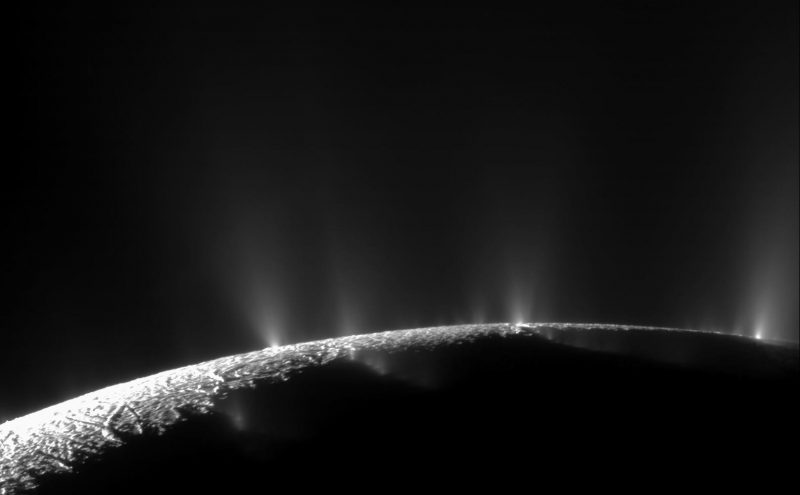“We’re coming up on the plumes!” The co-pilot announced over the intercom. The other six passengers and I took our positions along the viewing cupola at the belly of the “Tour Bus”, and each grabbed on to the hand and foot restraints to keep ourselves in place in the weightlessness. We were traveling about 1000 miles above the south pole of Enceladus looking down at the highly reflective surface that was so bright it took about a minute for our eyes to adjust.
We all remained silent, and my heart was pounding in anticipation. The Tour Bus silently coasted for a few more minutes as we took in the breathtaking view of Saturn’s sixth-largest moon. The water vapor plumes of Saturn’s moon Enceladus.
(Credit: NASA/JPL/Space Science Institute) Just then, tink. Another tink. Then another.
We knew something was hitting the spacecraft, but we weren’t sure what. I got a sudden rush of fear and felt my heart jump to my throat. What was hitting us, and will it get bigger? Are we in danger? Why hasn’t the captain ordered us back to our seats? The sound got louder and more frequent and some of the passengers started to panic.
That was when we all saw it, the first of three “tiger stripes” that marked the south pole of Enceladus. Just then a small object the size of a pea struck the cupola directly in front of my face and caused me to jump back, but I forced myself to hold on to the restraints. Another one struck.
Then another. This was when we all realized the initial sounds were ice particles emanating from the plumes and striking the Tour Bus, all being catapulted out of the moon through the stripes and into space. The particles continued to strike the cupola and harmlessly bounce off while we watched in amazement.
The Tour Bus continued to pass over the three stripes one at a time as we gazed down into the giant fissures where the particles came from, knowing that mere seconds earlier they were liquid water that swirled around inside the icy moon. We all strained to see down into the fissures to try and see the bottom, but to no avail. What was down there in the swirling depths? Was there life? Was it like life on Earth, or something more different? More alien? All we knew was these ice particles were from an alien world.
These are the Plumes of Enceladus. —————————————————– While Enceladus was first discovered by William Herschel in 1789, it didn’t get its first closeup study until it was visited by NASA’s Voyager 2 spacecraft, which revealed a differentiated surface with some heavily crated areas while other areas appeared to be crater-free. The plumes themselves went unnoticed until NASA’s Cassini spacecraft first imaged water and other volatiles erupting from the south pole in January and February 2005.
Cassini’s mass spectrometer ultimately detected an abundance of organic molecules—the building blocks of life—emanating from the satellite’s interior ocean. In March 2008, Cassini flew through the plumes and identified methane, molecular hydrogen, carbon dioxide, and rock fragments while measuring the speed of the material being catapulted from the moon at 1,300 km/hour (800 miles/hour). The source of the plumes is from the three “tiger stripes” at the south pole, which are four linear fractures generally measuring 130 km (80 miles) in length, 2 km (1.
2 miles) wide, and 500 meters (1640 feet) deep, and bordered by 100-meter-high (328-feet-high) ridges. “Tiger stripes” of Enceladus. (Credit: NASA/European Space Agency/JPL/Cassini Imaging Team) While existence of the plumes is indicative of an interior ocean, there has been debate on how much of an ocean exists beneath the moon’s icy crust.
Initially, it was speculated the ocean only existed in the south pole region, but scientists have since settled on the hypothesis of a global ocean. The presence of plumes and an interior ocean undoubtedly opens the possibility for potentially finding life on Enceladus. However, since the Cassini mission ended in 2015, there are currently no active missions in the outer solar system.
This might change with the latest recommendation from the planetary science decadal survey, which proposes the Enceladus Orbilander, a combination orbiter and lander meant to explore the potential habitability of the icy moon. If ultimately selected, the mission will launch in the 2030s with a landing in the 2050s. Saturn’s moon, Enceladus.
(Credit: NASA/JPL/Space Science Institute) Is there life lurking beneath the icy crust of Enceladus? Is it like life on Earth, or something different? Only time will tell, and this is why we science! Sources: NASA, Science, The Planetary Society, NASA (2), NASA JPL, The Christian Science Monitor, EarthSky, SpaceNews As always, keep doing science & keep looking up! The post Solar System Tours: Plumes of Enceladus appeared first on Universe Today. .
From: universetoday
URL: https://www.universetoday.com/156861/solar-system-tours-plumes-of-enceladus/



